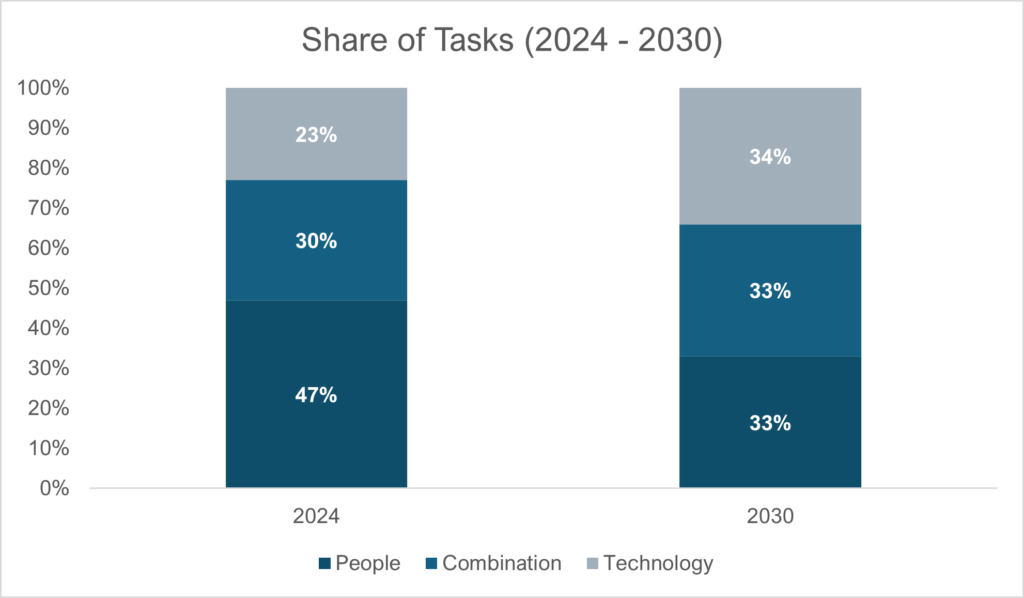The global job market is experiencing a rapid transformation, influenced by macroeconomic shifts, technological advancements, and demographic changes. Chapter 2 of the World Economic Forum’s Future of Jobs Report 2025 presents an in-depth analysis of the jobs outlook and evolving employment landscape, focusing on job creation, displacement, and the skills needed to thrive in the coming years. This chapter highlights industries that will expand, those that will contract, and the broader trends shaping the jobs outlook and the future of work. Understanding these insights is crucial for businesses, policymakers, and workers who seek to remain competitive in an increasingly unpredictable labor market.
The Changing Job Landscape: Job Growth vs. Decline
Over the next decade, structural labor-market transformations will impact nearly 22% of current jobs. The report projects that by 2030, around 170 million new jobs will be created, representing a 14% increase in global employment. Simultaneously, 92 million jobs are expected to be displaced, amounting to an 8% decline. This results in a net employment increase of 78 million jobs, equating to a 7% rise in global employment. While this overall increase in employment appears promising, the impact will not be uniform across industries. Some sectors will see significant expansion due to emerging technologies and shifting consumer demands, while others will contract due to automation, outsourcing, and changing economic pressures.
The Impact of Technology on Job Creation and Displacement
The evolving jobs outlook presents a unique intersection between technology and employment, highlighting the importance of adaptability. Technology will be the most significant factor driving labor-market changes, creating and displacing more jobs than any other macrotrend. Broadening digital access will lead to the creation of 19 million new jobs, but it will also render 9 million roles obsolete. AI and information processing technologies will contribute to an additional 11 million jobs, yet at the same time, they will lead to the loss of another 9 million. Robotics and autonomous systems, while contributing to efficiency and productivity, are expected to be a net job displacer, with 5 million more jobs lost than gained.
The impact of these technological trends will be felt across various industries, shaping both the fastest-growing and most rapidly declining job roles. AI, automation, and digital transformation will increase demand for data scientists, AI specialists, and cybersecurity analysts, while administrative and clerical positions, including legal secretaries and graphic designers, will decline. This marks a shift from previous job market forecasts, underscoring the growing influence of AI in performing complex cognitive tasks.
Automation vs. Augmentation: The Changing Nature of the Jobs Outlook
The relationship between humans, machines, and algorithms is reshaping job roles across industries. Companies anticipate a significant shift in task allocation between human workers and machines by 2030. Currently, nearly half of all tasks are completed exclusively by humans, while automation accounts for 22% and human-machine collaboration makes up the remaining 30%. However, by the end of the decade, the proportion of tasks performed solely by humans is expected to decline significantly. Automation will account for approximately 33% of tasks, while human-machine collaboration will become an even more dominant feature of the workplace. The share of tasks is shown in the graph below.

Industries such as insurance, finance, and telecommunications will experience the highest levels of automation, as companies increasingly rely on AI-powered tools to handle data processing, risk assessment, and customer service functions. In contrast, sectors like healthcare and government services will continue to rely on human expertise, integrating AI and digital tools to enhance productivity rather than fully replace workers. This shift underscores the importance of striking a balance between automation and augmentation. While automation removes repetitive and manual tasks, augmentation enhances human capabilities, enabling workers to focus on problem-solving, creativity, and decision-making.
The Role of Economic and Demographic Trends in Job Creation
Beyond technological advancements, economic uncertainty and demographic shifts will play a crucial role in shaping labor markets. Rising costs of living and slowing economic growth are expected to have a profound impact on employment trends. According to the report, half of all employers believe that increasing living costs will drive changes in workforce strategies, while 42% of businesses anticipate that slower economic growth will affect hiring decisions. As companies face mounting financial pressures, hiring may slow down, and employees may need to adapt by developing new skill sets or taking on multiple roles within organizations.
Demographic changes will also reshape labor markets across different regions. In high-income countries, aging populations will lead to increased demand for healthcare professionals, caregivers, and educators, as older generations require more medical and social support services. Meanwhile, lower-income economies will experience a surge in youth populations, creating an urgent need for large-scale job creation in sectors such as education, digital services, and entrepreneurship. Bridging skill gaps will be a critical challenge for both developed and developing economies, requiring significant investment in education and workforce training to prepare workers for future job opportunities.
Upskilling and Reskilling: The Key to Workforce Adaptation
As automation and digital transformation accelerate, nearly 39% of today’s skills will become obsolete by 2030. This underscores the urgent need for businesses and individuals to prioritize upskilling and reskilling efforts. According to the report, 85% of employers plan to invest in workforce training, while 70% expect to hire employees with new skill sets. Additionally, 50% of businesses aim to transition workers from declining job roles into emerging ones, ensuring that they remain relevant in the evolving labor market.
The most in-demand skills of the future will include analytical thinking, AI and big data literacy, cybersecurity expertise, creative problem-solving, and adaptability. In addition to technical proficiencies, soft skills such as leadership, emotional intelligence, and communication will gain importance as AI takes over repetitive and task-based roles. The ability to work alongside AI systems, interpret complex data, and exercise critical thinking will be essential for career success in the future workforce.
Geoeconomic and Environmental Factors Shaping Job Trends
Geopolitical and economic fragmentation will also influence employment trends, particularly in industries related to logistics, security, and strategic advisory roles. Government policies, trade restrictions, and rising geopolitical tensions are expected to drive demand for business intelligence analysts, supply chain specialists, and cybersecurity experts. Interestingly, while many companies have historically relied on offshoring strategies to reduce labor costs, an increasing number of businesses are now reshoring operations to mitigate risks associated with global supply chain disruptions.
Another key driver of job growth will be the green transition. Climate change adaptation is projected to contribute 5 million net new jobs by 2030, while climate change mitigation efforts will generate an additional 3 million jobs. The shift towards renewable energy and sustainable practices will drive demand for environmental engineers, renewable energy technicians, and sustainability specialists. Recent hiring trends indicate that “green jobs” have consistently outperformed overall labor market growth, highlighting the increasing importance of environmental sustainability in workforce planning.
Preparing for the Future of Work
As industries continue to evolve, the job market will increasingly favor technology-driven roles such as AI specialists, cybersecurity professionals, and renewable energy engineers. Conversely, clerical and administrative jobs will see significant declines due to automation. The future of work will not be defined solely by technology, but by the ability of workers and businesses to adapt. Human-machine collaboration will play a critical role, as companies integrate AI and automation into their operations while still valuing human expertise.
Lifelong learning and adaptability will become non-negotiable for career success. Workers who invest in continuous education and acquire digital and analytical skills will have a competitive edge in the job market. At the same time, businesses must take proactive steps to reskill their workforce, ensuring that employees are equipped to handle emerging challenges and opportunities. Companies that fail to invest in upskilling risk falling behind in an increasingly technology-driven economy.
Conclusion for Job Creation
The Future of Jobs Report 2025 offers a comprehensive perspective on the evolving employment landscape. While automation, economic factors, and demographic shifts will disrupt traditional job structures, they also present opportunities for innovation, workforce transformation, and new career pathways. For individuals, staying agile and embracing lifelong learning will be key to career resilience. For businesses, success will depend on their ability to balance automation with human expertise while prioritizing workforce development.
As the job market continues to shift, those who proactively adapt will thrive in this new era of work. Stay tuned for the next part of our Future of Jobs Report 2025 series, where we will explore the changing demand for skills and education pathways in the global workforce.
Read: The Future of Jobs 2025: Thriving Labor Market for Building a Bright Opportunity
